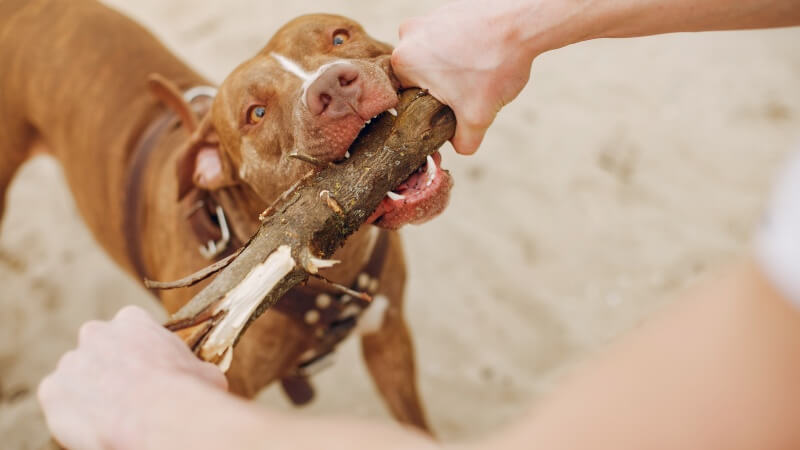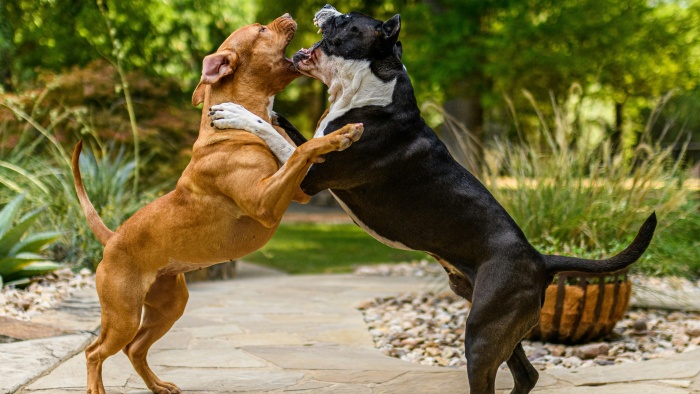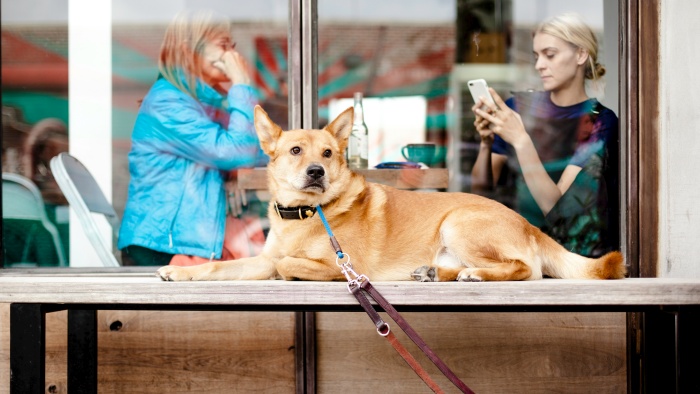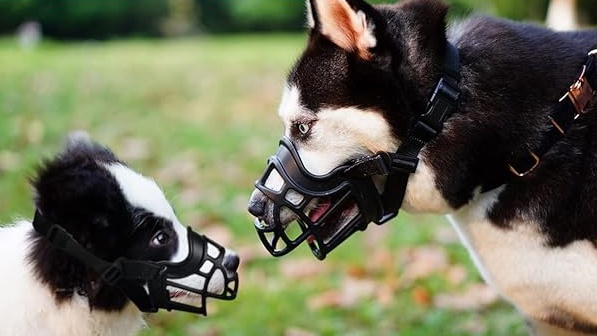My Dog Bit Me: How To Stop That?

A dog that bites poses a threat, not solely to humans but to itself as well. When my dog bit me, it underscored this danger. Though exact numbers of dogs euthanized for biting are not known, such behavior significantly increases their euthanasia risk.
Why do dogs resort to biting?
It’s crucial to recognize that, barring illness, dog bites stem from provocation. Thus, an initial action should be a comprehensive veterinary examination.
Regrettably, in the absence of a dog-to-human translation guide, signals that a dog is expressing concerns like, “I’m feeling uneasy here. Isn’t it clear I want you to STOP?” often go unnoticed. For a dog riddled with anxiety, escalating to growling, showing teeth, snapping, or biting “suddenly” becomes the next course of action.
The American Veterinary Medical Association (AVMA) notes that dogs bite in response to a trigger. If placed in a tense scenario, a dog might bite to safeguard itself or its territory.
Dogs might lash out due to fear, surprise, or perceived threats.
They might also bite to defend possessions they cherish, such as their offspring, their meals, or a toy.
Additionally, dogs may nip or bite during playful interactions. Although such nipping might seem harmless or enjoyable to the dog, it poses risks to humans. Refrain from engaging in rough play or tug-of-war with your dog. These activities can overstimulate your dog, potentially leading to a nip or bite.
Signs to observe
We provide these recommendations for pet owners:
- Should your dog show discomfort in certain scenarios, become their protector. Maintain a firm grip on the leash, while comforting and rewarding them; this technique effectively reduces anxiety through positive reinforcement.
- Pay attention to their non-verbal cues. Note any instance where your dog has shown aggression or fear, and handle future similar situations with greater care.
- It’s crucial to afford your dog some privacy from individuals who may be too eager to interact. Allow them space to relax, equipped with their food and toys. Background music might also help in calming them down.

How to teach your dog to avoid biting
Tales of unleashed Pitbulls attacking kids on their way to school are widespread, yet the majority of dog bites happen within the confines of the owner’s residence. Sixty-one percent of dog bites take place at home or in a known environment, with 77% of the victims being relatives or acquaintances.
How to prevent your dog from biting
Resorting to physical punishment like hitting or slapping is the least effective strategy for dealing with a dog’s aggression. Such actions are not only inhumane but counterproductive, as evidence indicates that dogs subjected to harsh discipline may exhibit increased aggression. Physical punishment triggers stress responses in dogs, similar to humans, complicating their ability to settle.
Moreover, punitive measures can erode the trust between you and your dog, making it challenging, sometimes impossible, to rebuild that bond.
Addressing your dog’s aggression begins with reinforcing non-aggressive behaviors with rewards. Other strategies for behavior modification include:
- Early socialization is crucial, according to the AVMA, for preventing biting by making your dog comfortable in various scenarios. Introduce your dog to a wide range of people and animals early on to help it adapt more easily as it ages. Leashing your dog in public places is also vital for maintaining control.
- Behavior Management. This approach limits your dog’s quality of life, including no more walks in parks, car rides, or alone time outdoors. Restrict your dog’s access to people outside the immediate family. Use a crate or separate room to isolate your dog when guests are present.

If a dog has a history of biting, any interaction with children, even if the dog generally likes kids, poses a risk. Without full confidence in managing your dog’s stress triggers, it’s unsafe to expose children to potential harm.
- Training. Obedience training is invaluable for dogs of all ages, enhancing safety around family and friends. It positively addresses many underlying causes of biting by helping with focus, impulse control, and correcting problematic behaviors.
- Best Friends Animal Sanctuary offers tips for ensuring safety:
- Post training protocol signs at home for consistent family involvement
- Install barriers like doors and gates as needed
- Train your dog to find comfort in a crate
- In public, have your dog wear a “Dog in Training” vest
- Acclimate your dog to a basket muzzle
- Offer high-value treats through the muzzle
- Consider supplements or CBD oil for emotional regulation

Adjust management strategies to fit your unique home and dog. Training your dog to accept a muzzle can safeguard both your pet and others. A muzzle should be associated with positive experiences to avoid discomfort during training.
Acknowledging your emotional state is crucial; anxiety about potential biting can increase the likelihood of such behavior. A muzzle can alleviate your worries, aiding in a more effective training process.
- Consulting a relationship-based trainer or a certified behavior consultant can provide tailored support for your dog’s challenges.
Training against biting demands commitment. For additional guidance, consult your vet or a reputable animal behaviorist for referrals.
Conclusion
Addressing the issue of biting requires a multifaceted approach, emphasizing understanding, prevention, and training. When my dog bit me, it was a clear sign of the urgent need for a compassionate and strategic response to this behavior.
By recognizing the provocation behind the bite, ensuring early socialization, implementing behavior management strategies, and engaging in consistent training, we can significantly reduce the risk of future incidents.
This comprehensive method not only safeguards humans but also protects our canine companions from the consequences of their actions. It’s about building a relationship based on trust and respect, where safety and mutual understanding pave the way for a harmonious coexistence.
Always remember, the goal is to create a safe environment for everyone involved, reinforcing positive behaviors and addressing the root causes of aggression without resorting to punitive measures.
FAQs
What should I do immediately after my dog bites someone?
After a dog bite occurs, ensure the safety of all involved by separating the dog from the situation. Provide first aid to the bite victim and consult medical professionals for advice. It’s also important to document the incident, including any circumstances leading up to the bite, and contact your veterinarian to discuss the next steps for evaluating your dog’s health and behavior.
Can a dog that has bitten once be trained not to bite again?
Yes, with proper intervention and training, a dog that has bitten can learn to manage its impulses and react differently to stressful situations. Consistent training, behavioral therapy, and sometimes lifestyle adjustments are necessary to reduce the likelihood of future incidents. Working with a professional trainer or behaviorist can provide the best strategy tailored to your dog’s specific needs.
How can I tell if my dog is getting too stressed in a situation?
Signs of stress in dogs include excessive yawning, licking lips, panting, avoiding eye contact, tucking their tail, lowering their body, or trying to escape the situation. Recognizing these signs early can help prevent a situation from escalating to a bite.
Are certain breeds more likely to bite than others?
While some breeds may have a reputation for being more aggressive, any dog can bite under the right circumstances. Factors such as the dog’s upbringing, training, socialization, health status, and the immediate environment play a more significant role in a dog’s likelihood to bite than its breed.
What steps can I take to socialize my dog effectively to prevent biting?
Effective socialization involves exposing your dog to a variety of people, animals, environments, and situations in a controlled and positive manner. Start this process early in your dog’s life and continue throughout adulthood. Always monitor your dog’s reactions and comfort levels, and retreat from situations if your dog shows signs of stress or discomfort. Engage in positive reinforcement to reward calm and non-aggressive behaviors during these interactions.

